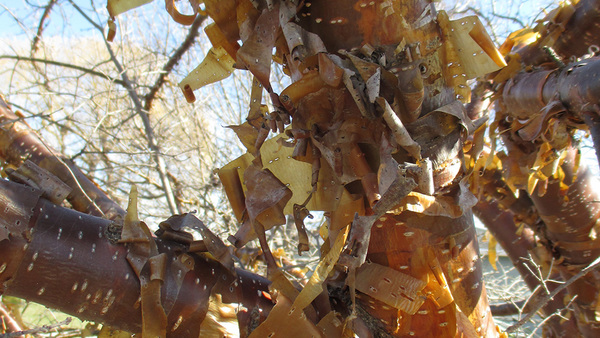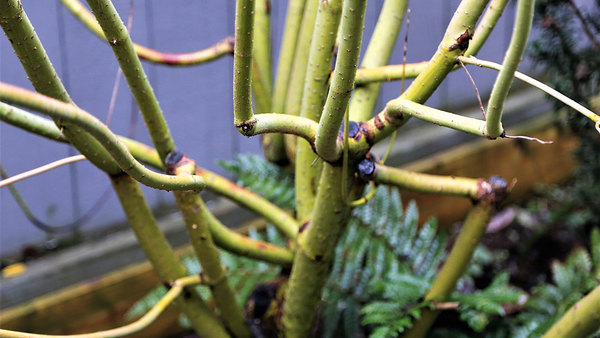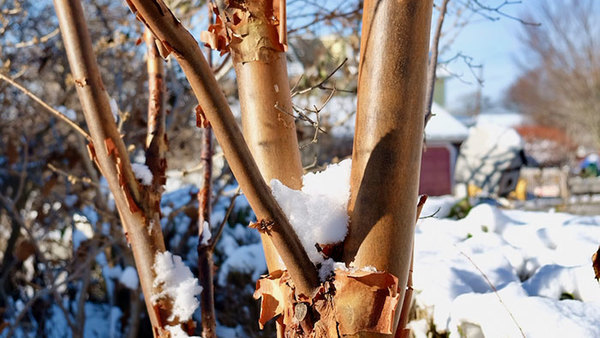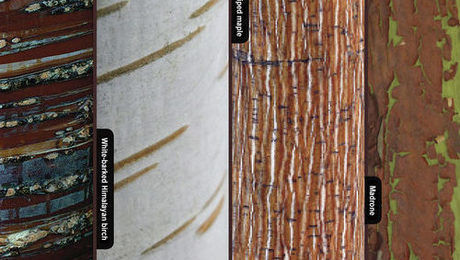
In Minnesota, where the leafless season can last nearly six months, it’s essential to consider winter interest when designing a landscape. But even if you live in a milder climate, where winter may be only a chilly month or two, it’s still worthwhile to select a few plants that will enliven the winter view.
Unusual branch structure, colorful fruit, and persistent seed heads can all give a woody plant winter interest, but unusual bark characteristics can be particularly eye-catching. Trees and shrubs that have colorful, exfoliating, or shiny bark can make outstanding additions to the winter landscape. In spring, summer, and fall, the foliage or flowers of these plants are likely to be their most noticeable feature, but once the leaves drop and the snow starts to fall, their dramatic bark takes center stage.
Stem colors range from red to yellow to orange

The showiest plants for winter interest are those with bright red, yellow, or orange bark. Few plants have more colorful winter bark than red-stemmed dogwood (Cornus sericea), a large shrub growing to 6 to 8 feet tall if unpruned, with a wide native range in the United States and Canada. Stem color within the species varies from bright red to dark burgundy-red. Several cultivars, including ‘Cardinal’ and ‘Baileyi’ (sometimes listed as a species rather than a cultivar) are known for outstanding red stem color.
Yellow-stemmed dogwood cultivars can also add a bright highlight to the winter landscape. ‘Bud’s Yellow’ Tatarian dogwood (Cornus alba ‘Bud’s Yellow’) is one of the best and seems to be more resistant to stem cankers than ‘Flaviramea’, the most commonly sold yellow-stemmed cultivar of C. sericea.
If you peeked under the foliage of any of these dogwoods in summer you might be surprised to see that the stems are green. The stems develop their bright colors with the onset of cold weather, remain colorful through the winter, then gradually return to green as temperatures warm in the spring. All of the shrub dogwoods are easy to grow in full sun or partial shade and wet to moderately dry soils.
The brightest color appears on year-old stems, so regular pruning is essential to keep these plants colorful. The key is to prune out old stems in spring to encourage new stems to grow from the base. Overgrown shrub dogwoods can be renewed by pruning all stems down to within a few inches of the base.
Coral-bark willow (Salix alba ‘Britzensis’) rivals even the brightest red-stemmed dogwood for winter color. With its golden stems and red-orange twigs, this willow can grow into a fairly large tree. It’s best to cut the plant nearly to the ground each year in early spring, producing a medium-size shrub composed entirely of colorful young stems that will glow in the winter landscape. Like most willows, this selection prefers full sun and moist soil.
Peeling curls of bark reveal an array of colors


While their colors are more subtle, several trees with exfoliating bark are also wonderful additions to the winter landscape. I think of exfoliating bark in two categories: bark that peels and curls in papery sheets and bark that shows patches or flakes of different colors.
Of the trees with peeling curls of bark, perhaps the most lusted after is paperbark maple (Acer griseum). This small, slow-growing tree has attractive dark-green trifoliate leaves, but it’s the bark that makes it special. Deep cinnamon-brown to mahogany from trunk to branch tips, the bark exfoliates in lovely papery curls. Paperbark maple makes an excellent specimen tree and will grow best in full sun to partial shade and moist but well-drained soil; it should be planted where you can admire it often.
Several birch species are also noted for their attractive bark, but river birch (Betula nigra) wins the award for abundance of papery curls. As the bark peels in shaggy masses, many colors are exposed, from ivory to tan, ash brown, cinnamon, and even rusty pink. Look for the selection Heritage® for consistently attractive bark and good foliage. River birch performs well in sun to partial shade but needs evenly moist soil and may become chlorotic in alkaline soils.
Plants with patchy exfoliating bark present an intriguing jigsaw-puzzlelike pattern in the winter landscape; a favorite of mine is lacebark pine (Pinus bungeana). This medium-size pine often grows with multiple trunks, which allows a good view of the wonderful brown, olive green, and whitish-gray bark patches. The common crape myrtle (Lagerstroemia indica), a multitrunked small tree, also has wonderfully mottled exfoliating bark. Some of the crape myrtle hybrids (Lagerstroemia indica × L. fauriei) introduced by the National Arboretum are particularly noted for multicolored bark in shades of tan, gray, and reddish brown. Both the lacebark pine and the common crape myrtle prefer full sun and well-drained soil.
Outstanding plants for winter bark interest
Color
Acer palmatum ‘Sango Kaku’ (coral-bark Japanese maple)
Height/width: 20/15
Zones: 5–7
Winter feature: Bright coral-red twigs in winter
Cornus alba (Tatarian dogwood)
Height/width: 8/6
Zones: 3–7
Winter feature: Variably red stems
Cornus alba ‘Alleman’s Compact’
Height/width: 5/5
Zones: 3–7
Winter feature: Red stems
Cornus alba ‘Bud’s Yellow’
Height/width: 7/7
Zones: 3–7
vBright-yellow stems
Cornus alba Ivory Halo®
Height/width: 6/6
Zones: 3–7
Winter feature: Dark-red stems, variegated foliage
Cornus alba ‘Sibirica’
Height/width: 7/7
Zones: 3–7
Winter feature: Vibrant red stems
Cornus sanguinea ‘Winter Flame’ (‘Winter Flame’ bloodtwig dogwood)
Height/width: 8/8
Zones: 5–7
Winter feature: Stems changing from yellow to red
Cornus sericea (red-stemmed dogwood)
Height/width: 8/8
Zones: 3–7
Winter feature: Stems in shades of red
Cornus sericea ‘Baileyi’
Height/width: 8/8
Zones: 3–7
Winter feature: Deep-red to burgundy stems
Cornus sericea ‘Cardinal’
Height/width: 8/8
Zones: 3–7
Winter feature: Bright cherry-red stems
Cornus sericea ‘Flaviramea’
Height/width: 8/8
Zones: 3–7
Winter feature: Yellow stems
Cornus sericea ‘Ruby’
Height/width: 8/8
Zones: 3–7
Winter feature: Rich ruby-red stems
Cornus sericea ‘Silver and Gold’
Height/width: 8/8
Zones: 3–7
Winter feature: Yellow stems, variegated foliage
Cornus sericea ‘White Gold’
Height/width: 8/8
Zones: 3–7
Winter feature: Golden stems, variegated
Kerria japonica (Japanese kerria)
Height/width: 4/6
Zones: 5–9
Winter feature: Bright-green winter stems
Kerria japonica ‘Kin Kan’
Height/width: 4/6
Zones: 5–9
Winter feature: Yellow stems with green stripes
Rosa glauca (redleaf rose)
Height/width: 8/6
Zones: 2–8
Winter feature: Unusual waxy purplish stems
Salix alba ‘Britzensis’ (coral-bark willow)
Height/width: 30/20
Zones: 2–8
Winter feature: Golden stems, red-orange twigs
Salix ‘Golden Curls’ (golden-curls willow)
Height/width: 30/20
Zones: 4–8
Winter feature: Curly golden stems
Salix ‘Scarlet Curls’ (scarlet-curls willow)
Height/width: 20/15
Zones: 5–8
Winter feature: Curly reddish stems
Texture
Acer griseum (paperbark maple)
Height/width: 25/20
Zones: 5–7
Winter feature: Peeling cinnamon-colored bark
Acer triflorum (three-flowered maple)
Height/width: 25/20
Zones: 4–7
Winter feature: Peeling amber-to-tan bark
Betula nigra (river birch)
Height/width: 50/40
Zones: 4–9
Winter feature: Curly bark in tan, brown, coral
Lagerstroemia cvs. (crape myrtles)
Height/width: 20/15
Zones: 7–9
Winter feature: Multicolored bark patches
Pinus bungeana (lacebark pine)
Height/width: 30/25
Zones: 5–7
Winter feature: Jigsaw-puzzlelike bark patches
Stewartia pseudocamellia (Japanese stewartia)
Height/width: 25/15
Zones: 5–7
Winter feature: Bark in multicolored patches
Sheen
Betula alleghaniensis (yellow birch)
Height/width: 50/30
Zones: 3–7
Winter feature: Yellow-brown bark on stems
Betula lenta (sweet birch)
Height/width: 50/40
Zones: 3–7
Winter feature: Reddish-brown bark on stems
Prunus maackii (Amur chokecherry)
Height/width: 20/15
Zones: 3–6
Winter feature: Amber to copper bark
Prunus serrula (paperbark cherry)
Height/width: 20/15
Zones: 5–7
Winter feature: Cinnamon-colored bark
Sorbus aucuparia ‘Beissneri’ (‘Beissneri’ European mountain ash)
Height/width: 30/15
Zones: 3–6
Winter feature: Smooth copper-colored bark
Syringa pekinensis China Snow® (China Snow® Peking lilac)
Height/width: 20/15
Zones: 4–7
Winter feature: Shiny brown papery bark
Some shiny bark mimics bronze and copper


Trees that have especially shiny bark also provide visual interest during the winter months. Shiny bark can have such a rich sheen that the trees’ trunks look like softly burnished bronze or copper. This shiny bark reflects the low-angled rays of winter sunshine, providing a warm glow on the coldest days.
I planted an Amur chokecherry (Prunus maackii) in my front yard, clearly visible through my living room windows. I admire its lovely bark for months in the winter, though after a particularly long winter I’m plenty ready to see its foliage appear. Amur chokecherry is a hardy small tree with incredibly beautiful bark ranging in color from golden amber to copper to rich cinnamon brown. The bark retains this lovely color and gloss, even on the main trunk, for most of the tree’s life.
Another small tree with marvelously shiny bark is paperbark cherry (Prunus serrula). Its bark is an incredible glossy rich reddish brown, developing peeling curls with age. Paperbark cherry has a fairly limited growing range, but it’s well worth seeking out if your garden is in that range.
Both the Amur chokecherry and the paperbark cherry have the cultural requirements and limitations typical of the genus Prunus. They do best in sun to partial shade, require excellent soil drainage, and are likely to die promptly if planted in a soggy site. Borers can be a serious problem, although trees maintained in good health are less prone to damage from these pests. Girdling roots is a fairly common problem for Amur chokecherries; the best defense is to untangle crossing roots carefully when planting, and make sure the tree is not planted too deep.
These selections are just a sampling of those that can provide winter interest. Take a good look at your landscape through the winter months and note where you could use a splash of red, the textural accent of peeling bark, or a coppery sheen. As a lover of plants, I’d have to say that winter is not my favorite season, but living in Minnesota has made me appreciate those plants that are beautiful even when they’re deep in winter dormancy.
Fine Gardening Recommended Products

DeWalt Variable-Speed Cordless Reciprocating Saw with 6-Piece Saw Blade Set
Fine Gardening receives a commission for items purchased through links on this site, including Amazon Associates and other affiliate advertising programs.
- 18.31 x 6.13 x 4 inches
- 1-1/8-inch stroke length
- Variable speed trigger with 0-3000 spm
- DW4856 Metal/Woodcutting Reciprocating Saw Blade Set, 6-Piece

Pruning Simplified: A Step-by-Step Guide to 50 Popular Trees and Shrubs
Fine Gardening receives a commission for items purchased through links on this site, including Amazon Associates and other affiliate advertising programs.

ARS Telescoping Long Reach Pruner
Fine Gardening receives a commission for items purchased through links on this site, including Amazon Associates and other affiliate advertising programs.


















Comments
A southern California friend was just mentioning today that he is amazed at the difference it makes to see a bare tree vs the mostly year-round green foliage in warmer climates. There is something strangely calming about watching the branches sway back and forth in the wind, right? Of course, the falling leaves and other debris aren't fun to clean up or keep out of unprotected rain gutters. Jeff Morgan - Community Manager @ MoonWorksHome.com
Log in or create an account to post a comment.
Sign up Log in